Budapest Essentials: Currency, Transportation, Safety and Cultural Tips
Plan Smarter
Your Complete Budapest Essentials Guide
Planning your trip to Budapest? Whether it’s your first visit or you’ve been before, understanding the essentials can save you time, money, and stress.
This guide walks you through everything you need to know before you go — from what currency to carry and how to get around, to local safety tips, must-know holidays, and cultural customs that’ll help you blend in with confidence.
Budapest is more than just thermal baths and stunning architecture — it’s a city with its own rhythm, rules, and routines. To help you travel smarter, we’ve broken down the practicalities that matter most. You’ll find helpful summaries on public transport, tipping etiquette, local SIM cards, neighborhood safety, and more — all grounded in real traveler needs.
Let’s get you ready to experience Budapest without confusion. Start with the essentials below, and dive deeper where needed through our focused guides.
Here’s what this guide covers:
Prepare for your visit to Budapest
Budapest: the basics
Are you wondering about Budapest’s time zone? The currency used? Do you want to know what kind of adapter you should bring to Hungary? Here are the basics.

Budapest time zone
UTC + 1
Hungary uses the system of DST (Daylight Saving Time).

Hungarian currency
Hungarian forint (HUF)
Budapest currency essentials: Money guide for travelers

Country code
+36 …
Budapest’s area calling code is (1).

Budapest airport
Ferenc Liszt International Airport

Electrical plug adapter type
Socket type C or F plug adaptor
Standard voltage in Hungary is 220-240 V, AC: 50 Hz.

Emergency phone number
112
Call anytime for free to reach the fire service, ambulance and the police.
What currency do I need in Budapest?
Hungarian Currency & Payment Guide
The official currency in Budapest is the Hungarian Forint (HUF). While some tourist-focused places may accept Euros, it’s not reliable — and you’ll likely get a poor exchange rate. For the best value and smoothest experience, plan to pay in Forint, whether by cash or card.
Can I use my credit card in Budapest?
Yes — credit and debit cards are widely accepted, especially in hotels, restaurants, and supermarkets. Visa and Mastercard work almost everywhere.
Smaller kiosks, street vendors, and some cafés may still be cash only, so carrying some Forint is a smart backup.
What about ATMs?
ATMs are easy to find throughout the city. Avoid Euronet machines (often in blue/yellow) as they charge high fees.
Instead, use machines operated by banks like OTP, Erste, or Raiffeisen. Always choose to be charged in Forint, not your home currency, to avoid poor conversion rates.

Tip:
Revolut, WISE, and other travel cards are popular with visitors. They offer excellent exchange rates and easy ATM access, especially if you’re topping up in HUF directly.
For a full breakdown of best exchange methods, where to find no-fee ATMs, and live cost comparisons, visit our Complete Budapest Currency Guide.
Typical Prices in Budapest (2025)
| Item | Average Cost (HUF) | Approx. in EUR |
|---|---|---|
| Coffee (espresso) | 600–900 HUF | €1.50–€2.30 |
| Meal (mid-range) | 3,500–6,500 HUF | €9–€17 |
| Metro ticket (single) | 450 HUF | €1.15 |
| Thermal bath (entry) | 9,400 HUF | ~€24 |
| Beer (draft, local) | 800–1,200 HUF | €2–€3 |
Are Euros accepted in Budapest?
Euros are occasionally accepted in Budapest — some taxis, hotels, and tourist shops accept Euros, but not always. You’ll get a poor rate, and change is often returned in Forint. Budapest is not Euro-based, so it’s best to convert or withdraw Hungarian Forint.
Getting Around Budapest
Transportation in Budapest: Getting Around
Budapest’s public transportation system is efficient, affordable, and easy to use. It includes metro lines, trams, buses, and trolleybuses, all managed by the Budapesti Közlekedési Központ (BKK).
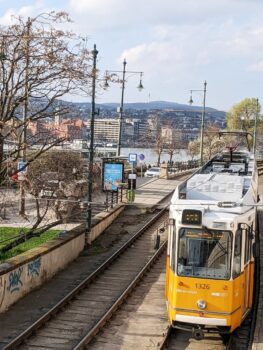
✴
What types of public transport are available?
- Metro: 4 lines (M1–M4) cover central and suburban areas.
- Trams: Iconic yellow trams (like Tram 2 along the Danube) run frequently and are ideal for sightseeing.
- Buses & Trolleybuses: Cover routes not served by metro/trams, including night buses.
All use the same ticket system, and transfers are allowed if using passes.
✴
How do tickets work?
You can choose from:
- Single Ticket: 450 HUF
- 10-Ticket Pack: 4,000 HUF
- 24h / 72h Travelcards: Unlimited use within timeframe
- Budapest Card: Includes public transport + attractions
Tickets must be validated before boarding (machines on platforms or vehicles). Fines for riding without a valid ticket are steep.
✴
Where to buy tickets?
- BKK purple ticket machines (multilingual)
- BKK customer service points
- BudapestGO app (iOS/Android)
- Newsstands and metro stations
💡 Locals often use the BudapestGO app to check live routes, buy mobile tickets, and plan transfers in real time.

Tip:
For more information about how to get around in Budapest with maps, insider tips, and cost-saving advice please see our full Budapest Transportation Guide.
Getting from Budapest Airport to the City
There’s no metro from the airport (Liszt Ferenc International Airport), but you have several options:
- 100E Airport Express Bus (direct to Deák Ferenc tér): 2,200 HUF, ticket required separately
- Bus 200E + Metro M3: Cheaper but requires transfer
- Taxi: Fixed rates with Főtaxi (~9,000–12,000 HUF to city center)
- Private shuttle or Bolt app: Varies by demand
For full comparisons, see our Getting from Budapest Airport to City guide.
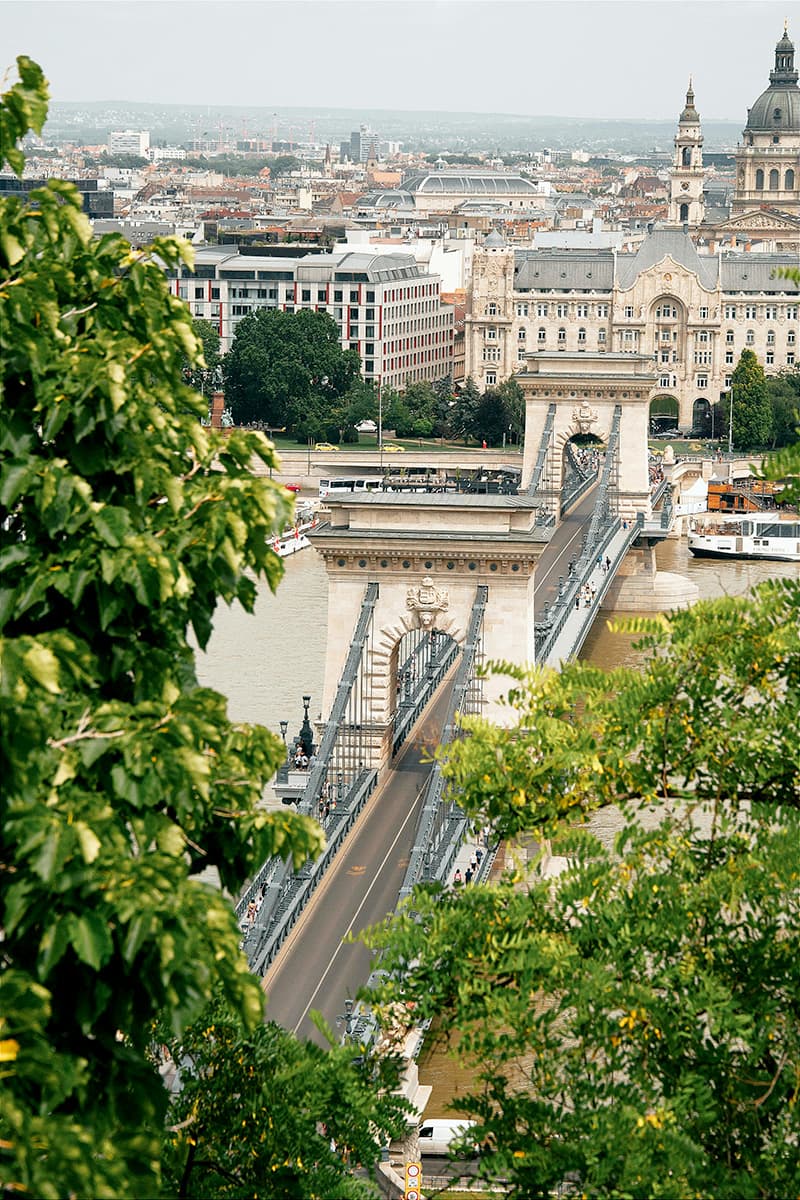
Practical Safety Tips
Is Budapest Safe for Travelers?
Yes — Budapest is generally a safe city for tourists. Violent crime is rare, and locals are welcoming to visitors. Still, like in any major city, you should stay alert to petty theft and common tourist scams in busy areas.
How safe is Budapest for tourists?
- Violent crime is rare. The city ranks high on European safety indexes.
- Petty theft (pickpocketing) can occur, especially on trams (like Tram 4/6), in crowded markets, and near tourist sites.
- Public transport, including at night, is generally safe and well-patrolled.
What scams should I watch out for?
- Overpriced taxis (always use licensed ones like Főtaxi or Bolt app)
- Fake police officers demanding to see your passport or wallet
- Bars or clubs with hidden charges (avoid being invited by strangers)
💡 Tip: If it feels off or too good to be true, it usually is. Avoid engaging with aggressive street solicitors.
What to do in an emergency?
- Emergency number: 📞 112 (works for police, ambulance, and fire)
- Police in Hungarian language: Rendőrség
- Closest major hospital with English-speaking staff: Honvédkórház
For embassy help, carry a digital or printed list of local embassy contacts.
What safety tips should I follow?
- Use crossbody bags or secure backpacks in busy areas
- Don’t leave belongings unattended at cafés, baths, or on trains
- At night, stick to well-lit streets and main boulevards
- Keep a digital copy of your passport and travel insurance

Tip:
For more information see our Budapest Travel Safety Tips page with location-based tips, scam alerts, and emergency resources — ideal for solo travelers and families.
Public Holidays in Budapest
Hungarian National Holidays & Closures
Hungary observes several national public holidays throughout the year, during which shops, banks, government offices, and even museums may close or operate on limited hours.
What are the main public holidays in Hungary?
Here’s a quick reference to the major holidays that most affect travelers:
| Date | Holiday Name | What’s Closed? |
|---|---|---|
| Jan 1 | New Year’s Day | Most shops, public offices |
| Mar 15 | Revolution Day (1848) | Banks, many museums, offices |
| Easter Sun/Mon | Easter (moveable) | Sunday: all closed, Monday: limited |
| May 1 | Labour Day | Full closures, some events |
| Aug 20 | St. Stephen’s Day (Founding) | Shops, offices; fireworks at night |
| Oct 23 | 1956 Revolution Memorial | Offices, museums, quiet city vibe |
| Nov 1 | All Saints’ Day | Cemeteries busy, shops closed |
| Dec 25–26 | Christmas Days | All closed, transport reduced |
What’s open and what’s not?
- Baths: Usually open but may have shorter hours (check ahead)
- Shops and malls: Closed on most national holidays
- Restaurants: Some stay open, especially in tourist areas
- Public transport: Runs on holiday/Sunday schedule (less frequent)
- Museums: Closed on many holidays, especially March 15, Aug 20, Oct 23, Dec 25–26
💡 If your visit overlaps with a holiday, book activities and restaurants in advance, especially around Christmas and Easter.

Need the full holiday calendar?
For more context, meanings, and cultural tips, check our full guide to Hungarian National Holidays — includes month-by-month closure tips, event suggestions, and what not to miss.

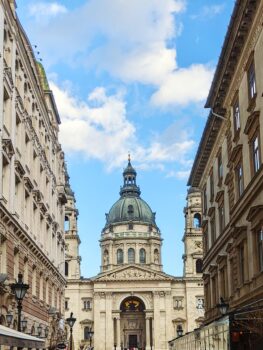
Short History of Budapest
History of Budapest (for Travelers)
Understanding Budapest’s past helps you better enjoy its architecture, thermal baths, and cultural layers — without needing a textbook.
Timeline Snapshot
- Roman Times: The area was once the Roman city of Aquincum, located in today’s Óbuda.
- Medieval Buda: From the 13th century, Buda became a royal seat on the west bank of the Danube.
- Ottoman Rule: The city was under Turkish occupation from 1541 to 1686 — many of today’s thermal baths date to this period.
- Habsburg & Austro-Hungarian Era: After liberation, Buda and Pest developed under Austrian rule, leading to ornate buildings and bridges.
- 1873: Buda, Pest, and Óbuda officially merged into one city: Budapest.
- 20th Century Turmoil: The city suffered during both World Wars, especially in 1944–45 under Nazi and Soviet sieges.
- Communist Period (1949–1989): Characterized by Soviet-style blocks, repression, and the 1956 Revolution.
- Modern Era: Since 1989, Budapest has developed into a vibrant EU capital with historic charm and modern energy.

Want a deeper look?
Take a look at our full History of Budapest for Travelers guide, with interactive timelines, historical sites, and walking route suggestions.
Budapest Customs
Cultural Etiquette & Local Customs in Budapest
We Hungarians are polite, reserved, and we are proud of our culture. As a traveler, a few small gestures go a long way in showing respect.
Greetings & Politeness
- Locals typically greet with “Jó napot” (good day) or “Szia” (hi, informal).
- Handshakes are common in formal settings; nods or hellos work casually.
- Always say hello when entering small shops or restaurants — it’s expected.
Dress Codes & Modesty
- Churches: Cover shoulders and knees — bring a scarf or light layer.
- Thermal baths: Swimsuits are required; no nude bathing in co-ed areas.
- Spas often provide paper slippers and towels, but flip-flops are useful to bring.
💡 Tip: Some traditional bathhouses have gender-separated days. Always check rules before visiting.
Dining Habits
- Don’t clink beer glasses — a national habit rooted in historical protest (1848 Revolution).
- Wait for everyone to be served before starting.
- Tipping: 10–15% is customary, but check if service is already included (often it is).
- Say “Egészségedre!” (cheers!) when toasting — eye contact is expected.
Quiet Hours & Public Behavior
- Quiet hours in residential areas: 22:00 to 06:00 — enforced in many hotels and Airbnbs.
- Public transport: Keep your voice down, offer seats to elderly or pregnant passengers.
- Locals rarely make small talk with strangers — it’s not rude, just cultural.
💡 You might find people a bit reserved at first — don’t confuse it with unfriendliness.

Want to dive deeper?
Take a look at our full Hungarian Etiquette Guide with cultural do’s and don’ts, body language tips, and behavior to avoid — especially useful for longer stays or remote workers.
Language Tips
Language Tips for Travelers
Hungarian (Magyar) isn’t easy, but learning a few basics can help you earn a smile — even in touristy areas.
Do I need to speak Hungarian in Budapest?
- Most younger people in the city speak some English.
- Menus and signs in central areas are often bilingual (HU/EN).
- Locals appreciate it if you try simple phrases, even if your pronunciation isn’t perfect.
💡 Tip: Download a translation app or use Google Lens for signs and menus.
Want more help?
Take a look at our Essential Hungarian for Travelers page with audio, practice tips, and printable phrase cards.
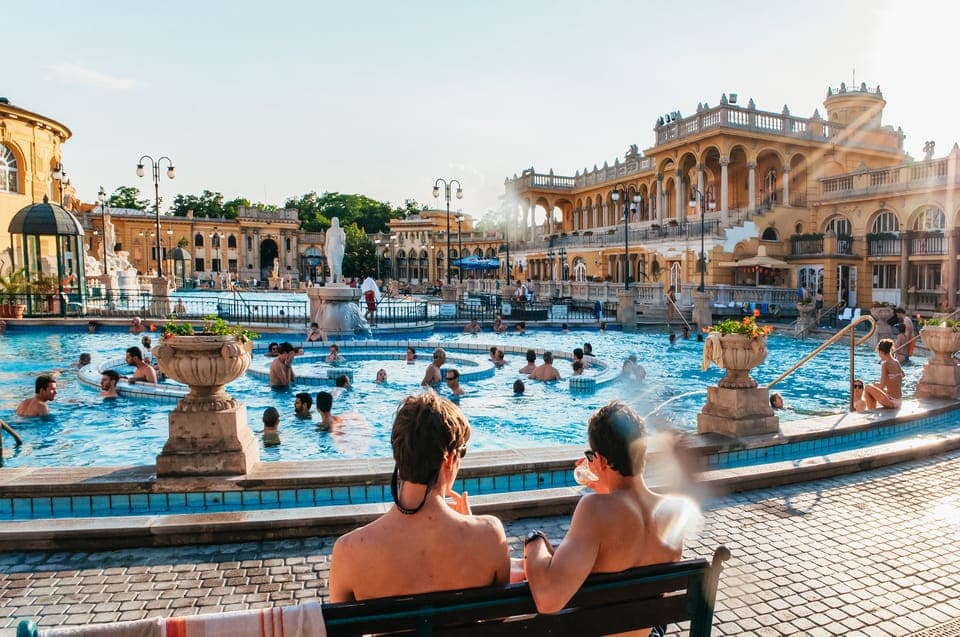
10 Useful Hungarian Words & Phrases
Hungarian phrases for tourists:
| English | Hungarian | Pronunciation |
|---|---|---|
| Hello | Szia / Jó napot | see-ya / yo NAW-pot |
| Thank you | Köszönöm | KØ-sø-nøm |
| Yes / No | Igen / Nem | ee-gen / nem |
| Please | Kérem | KAY-rem |
| Excuse me / Sorry | Elnézést / Bocsánat | el-NEH-zaysht / BO-cha-naht |
| Cheers | Egészségedre! | eh-GAYSH-sheg-ed-reh |
| How much is it? | Mennyibe kerül? | MEN-yee-be keh-rool? |
| I don’t speak Hungarian | Nem beszélek magyarul | nem BEH-seh-lek MAW-dyar-ul |
| Do you speak English? | Beszél angolul? | BEH-sayl AHN-go-lool? |
| Goodbye | Viszontlátásra | VEE-sont-laa-taash-ra |
Month-by-month calendar
When to Visit Budapest?
Budapest is a true year-round destination, but the vibe changes with the seasons. Here’s a quick orientation to help you plan smarter.
Not sure when to come? Take a look at our Best time to visit Budapest page.
Explore Budapest in Peak Seasons
High Season: June–August
What you can expect:
- Hot weather, long days, lots of tourists.
- Expect higher prices and busy attractions.
- Great for: Danube cruises, ruin bars, thermal baths by night.
- Avg. highs: 26–30°C (79–86°F)
More info:
- Budapest in June: activities, things to do and what to pack
- July in Budapest: things to do, events, festivals and what to pack
- Budapest in August: events, things to do, August 20th festivities

Enjoy Budapest with Lower Crowds
Shoulder Seasons: April–May & September–October
What you can expect:
- Milder weather, fewer crowds.
- Best balance of good weather + lower prices.
- Spring brings festivals and cherry blossoms; fall offers harvest season charm.
- Avg. highs: 15–23°C (59–73°F)
More info:
- Budapest in April: activities, things to do and what to pack
- May in Budapest: things to do, events, festivals and what to pack
- Budapest in September: events, things to do, harvest festivals
- October in Budapest: things to do, what to pack and events for autumn months

Explore Budapest in Low Seasons
Low Season: November–March
What you can expect:
- Cold, often grey, but cozy and cultural.
- Perfect for thermal spas, museums, cafés, and Budapest’s Christmas Markets (late Nov–Dec).
- Avg. highs: 3–10°C (37–50°F)
More info:
- Budapest in November: activities, things to do and what to pack
- December and Christmas in Budapest: things to do, events, festivals and what to pack
- Budapest in January: events, things to do and what to pack
- February in Budapest: things to do, Valentine’s day programs and what to pack
- Budapest in March: weather, what to pack and top things to do
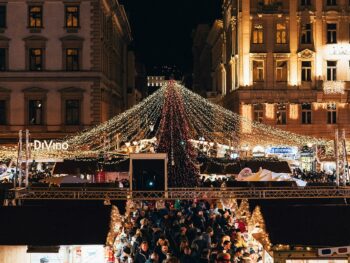
Budapest Accommodation Guide
Where to Stay in Budapest (By District)
The right place to stay depends on what kind of trip you’re planning — nightlife, family-friendly, river views, or quiet local charm. Here’s a quick breakdown to help you choose.
Pest vs. Buda
- Pest (east side of the Danube) – Lively, flat, central. Pest is better for nightlife and attractions. Most hotels are on the Pest side.
- Buda (west side) – Hilly, greener, quieter. Ideal for views, history, and relaxed stays. Buda is better for scenic views and quiet stays.
Want more help for finding the best place to stay?
👉 Check out our full Where to Stay in Budapest guide for:
- Interactive maps + safety tips
- Pros & cons of each district
- Best areas for families, solo travelers, or couples
- Hand-picked hotel recommendations

Key Budapest Districts at a Glance
| District | Area | Best For |
|---|---|---|
| I. (1.) | Castle District | History lovers, couples |
| V. (5.) | Inner City (Belváros) | First-time visitors, sightseeing |
| VI. (6.) | Terézváros | Access to Opera, Andrássy Ave, upscale |
| VII. (7.) | Jewish Quarter | Nightlife, ruin pubs, young travelers |
| VIII. (8.) | Józsefváros | Budget stays, local vibe |
| XIII. (13.) | Újlipótváros | Families, longer stays, local cafes, expats love this district |
Tips for helpful apps and passes
Useful Apps, Passes & Services for Budapest
A few smart downloads and travel tools can make your Budapest trip smoother, cheaper, and more local-friendly.
Public Transport: BudapestGO App
The BudapestGO app provides real-time schedules and route planning for Budapest’s metro, tram, bus, and trolleybus network. It features live arrival data and stop maps in English, making it essential for efficient travel within the city.
Google Translate (Hungarian ↔ English)
Google Translate helps travelers read Hungarian menus, signage, and even communicate with locals. Downloading the offline Hungarian language pack is recommended for use without data. Use Google Lens to translate signs on the go (just direct your camera and Lens will translate it real-time).
Budapest Card
The Budapest Card gives travelers unlimited public transportation, free access to 30+ museums, discounts at baths and restaurants, and free walking tours. It’s most valuable for short-term visitors planning a packed itinerary.
Is the Budapest Card Worth It? – read more in our review.
Bolt (Taxi & Ride-Hailing App)
Bolt is the most commonly used ride-hailing app in Budapest. Bolt app offers lower prices than traditional taxis and is especially useful for late-night travel or airport pickups.
Foodpanda (Food Delivery)
Foodpanda allows you to order food from local restaurants and major chains. It’s ideal for delivery to hotels or apartments, especially in the evening or during poor weather.
SIM Cards & eSIMs
Local SIM cards are available from One (former Vodafone), Telekom, and Yettel shops across Budapest. For budget travelers, Tesco Mobile offers affordable prepaid data plans. If you prefer digital solutions, eSIM providers like Airalo and Nomad allow instant mobile data activation before or during your trip.
Solo, family, group and senior travel in Budapest
Budapest for Solo Travelers, Couples, Families & Seniors
Budapest is not a one-size-fits-all city — whether you’re traveling solo, as a couple, with kids, or in your golden years, the city offers tailored experiences to match your style and pace.
Solo Travelers
Budapest is considered one of Europe’s safest and most walkable cities for solo travel. Most hostels and boutique hotels are centrally located on the Pest side (Districts 5, 6, and 7), and locals are used to tourists navigating alone.
Solo travelers often enjoy thermal baths, ruin pubs, and café culture.
📌 Explore Budapest with our 1-Day Solo Itinerary.
Couples
Romantic architecture, Danube cruises, and spa retreats make Budapest ideal for couples. Stay in District 1 (Castle area) for a quieter, scenic vibe or District 5 for stylish riverside hotels and walkability.
Couples often enjoy wine tastings, sunset viewpoints like Gellért Hill, and evening thermal bath experiences.
📌 Explore Budapest with our 1-Day Itinerary for Couples.
Families
With accessible transit, wide boulevards, and family-friendly attractions like the Budapest Zoo and City Park, the city is well-suited to families. Thermal baths with children’s areas (like Palatinus or Lukács) are a bonus.
Consider Districts 6 or 13 for quiet stays with parks nearby.
📌 Explore Budapest with our 1-Day Budapest Itinerary for Families.
Senior Travelers
Budapest’s relaxed pace and historic atmosphere appeal to older travelers. Elevators in metro stations, walkable core districts (1 and 5), and Danube cruises provide low-effort enjoyment.
Many baths offer quiet morning hours.
📌 Explore Budapest with our 1-Day Senior-friendly Itinerary.

Not sure how to make the most of your time in Budapest?
Start with our expert-designed Budapest itineraries tailored to solo travelers, couples, families, and more — built to save you time and avoid common tourist mistakes.
